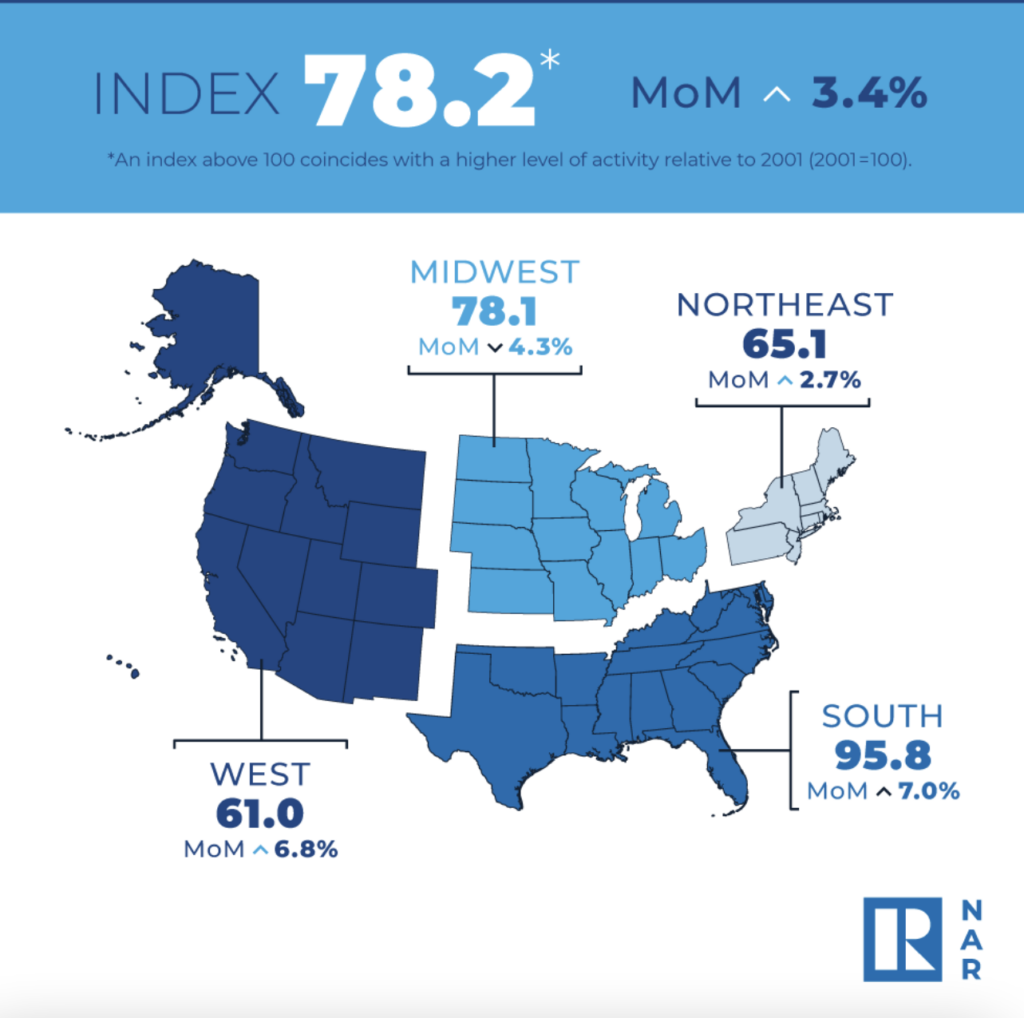In a new report, the National Association of REALTORS (NAR) reported that pending home sales increased by 3.4% in March. Transactions increased in the Northeast, South, and West each month, but the Midwest decreased. Year-over-year (YoY), the Northeast and South decreased, while the Midwest and West improved.
The Pending Home Sales Index (PHSI), a forecast of home sales based on contract signings, rose to 78.2 in March. YoY, pending transactions increased by 0.1%.
“March’s Pending Home Sales Index—at 78.2—marks the best performance in a year, but it still remains in a fairly narrow range over the last 12 months without a measurable breakout,” said Lawrence Yun, NAR Chief Economist. “Meaningful gains will only occur with declining mortgage rates and rising inventory.”
Max Slyusarchuk, Founder and CEO of A&D Mortgage, weighed in on pending home sales trends and what it could mean for potential homebuyers this spring season.
“The trend of Pending Home Sales remaining flat annually continues to be a concern as we get deeper into the Spring homebuying season,” Slyusarchuk said. “The yearly numbers are beginning to raise a red flag for the federal government. We don’t expect them to lower interest rates soon, but they must know that the market can’t continue like this for a third year. And so, we suspect additional housing stimulus initiatives will be announced by the end of this year, based on the current, feeble state of the housing market.”

NAR Unveils Quarterly U.S. Economic Forecast
NAR predicts that existing-home sales will increase by 9% in 2024 to 4.46 million (from 4.09 million in 2023) and by another 13.2% in 2025 to 5.05 million (from 2024). Housing starts are predicted to increase by 1.2% in 2024 to 1.43 million (from 1.413 million in 2023), and by 4.9% to 1.5 million in 2025 (from 2024).
“Home prices rising faster than income growth is not healthy and adds challenges for first-time buyers,” Yun said. “Home sales have lingered at 30-year lows, and since 70 million more Americans live in the country now compared to three decades ago, it’s inevitable that sales will rise in coming years,” Yun said. “Inventory will grow steadily from more home construction, and various life-changing events will require people to trade up, trade down or move to another location.”
According to the report, NAR experts believe that median home prices will rise by 1.8% in 2024 to a new high of $396,800 (up from $389,800 in 2023), and another 1.8% in 2025 to $403,800.
NAR predicts a 0.6% drop in the median new home price to $426,100 in 2024 (from $428,600 in 2023), reflecting the construction of smaller-sized homes. The association also predicts that the median new home price will rise 3.4% to $440,500 in 2025 (up from 2024).
“Home prices are expected to rise roughly in line with consumer price inflation and wage growth over the next two years,” added Yun. “Most homeowners are on strong financial footing in current market conditions, with only 2% of sales classified as being distressed.”
NAR predicts home sales to slowly improve while home prices continue to reach historic highs.
U.S. Pending Home Sales Regional Breakdown
The Northeast PHSI grew 2.7% last month to 65.1, down 0.3% from March 2023. The Midwest index declined 4.3% to 78.1 in March, up 1.3% from a year earlier.
The South PHSI increased 7.0% to 95.8 in March, down 1.5% from the previous year. The West index increased 6.8% in March to 61.0, up 3.6% from March 2023.
“Inventory will gradually rise from recent growth in home building. Additionally, many sellers who delayed listing in the past two years will start putting their homes on the market to move to a different home that better fits their new life circumstances—such as changes in family composition, jobs, commuting patterns and retirees wanting to be closer to their grandkids.”
Yun added, “Job gains, steady mortgage rates, and the release of inventory from pent-up home sellers will lead to more sales. Given the lingering housing shortage, home prices will march higher, albeit much more slowly than in the past.”
To read the full report, including more data, charts, and methodology, click here.










